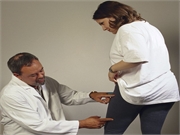FRIDAY, Nov. 29, 2019 (HealthDay News) — Leg pain while walking or doing other activities could be a sign of peripheral artery disease, an expert says.
Peripheral artery disease (PAD) develops silently, narrowing blood vessels until a shortfall in the supply of nutrients and oxygen causes cramps and leg pain, explained Dr. Faisal Aziz, chief of vascular surgery at Penn State Health Milton S. Hershey Medical Center.
“Pain with physical exertion is a classic, hallmark sign,” Aziz said in a Penn State Health news release. “When it gets really bad, it can form wounds on the legs that do not heal or cause blackening of the foot or toes.”
Risk factors for peripheral artery disease include age and gender. Men and all people 65 and older are most likely to develop the condition. Other risk factors include smoking, high blood pressure, high cholesterol, uncontrolled diabetes and heart disease.
Anyone who has risk factors and pain in their legs should talk to their doctor, Aziz advised.
“If you aren’t exercising or walking enough, you won’t even know you have it until it has silently progressed,” he said. “Most physicians will also recommend that you walk more to help the condition because that encourages your body to form other vessels around the blockage.”
Medications that treat risk factors such as high blood pressure, cholesterol and insulin levels may be helpful, but peripheral artery disease can’t be reversed after it starts.
“Whatever blockages have occurred will not go away unless they are stented or bypassed,” Aziz said. “But risk-factor modification can slow the progression of the disease.”
In cases where walking doesn’t improve the condition, 70% to 80% of patients can be helped with minimally invasive procedures in which balloons or stents are placed in blood vessels to improve circulation.
More serious cases may require surgical bypass, where blood is rerouted from the damaged vessel to a good one nearby, Aziz said.
More information
The American Heart Association has more on peripheral artery disease.
Copyright © 2025 HealthDay. All rights reserved.

